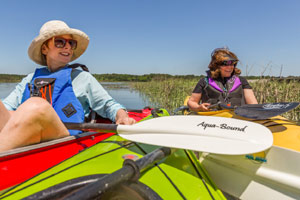Two spring weekends on a coastal Carolina island see college golfers from the Big East Conference’s nine universities tee up in one of golf’s most beautiful settings. They are aiming to win the conference championship for their school and a personal best for their scorecard. In the process, they point the way to the future of golf.
“If you squint your eyes a little as you watch the Big East Championship, you see three things that pave the way to a future for golf in this country,” said Jeff Spencer, Callawassie Island General Manager and PGA Ambassador. The success factors Spencer sees taking shape here are youth, coaching and growth.
The Youth
Clearly golf remains relevant for the young, as testified by the hundreds of rounds the student athletes play to prepare for these moments. Yet it would be a fair comment that they’re not exactly the main stream of young golfers. “College varsity golfers are the top one percent of the young people coming into the sport,” Spencer said. “But the influence they have will help spread golf to their friends, families and business associates for the rest of their lives.”
That influence is based on a human factor that is so deeply engrained in golf that it might go unnoticed, Spencer said. “It’s just more fun to play with people who truly love the sport. Their enjoyment is highly contagious.” As a result, the enthusiasm of these college golfers will ripple out to golfers all around them, for yet another generation. Surrounded by tidal rivers, in the lovely surroundings of Callawassie Island, this enjoyment clearly entered their memories for good.
The broad base of golf’s enjoyment is on display at the Big East Tournament, too, with women and men from around the nation and the world joining in. Among the young, it is even more obvious that there is no single golf “type.” Without a doubt, the pleasures of the outdoors, the challenge and the mastery of technique are not bounded by any one age group or kind of golfer.
To foster the all-important flow of young golfers into the sport, The Callawassie Island Club has stepped forward to become a host course for The First Tee, an international after-school and in-school golf program that presents golf skills as life skills for kids and teens. As a First Tee of the Lowcountry course, Callawassie Island is part of a movement that encourages integrity, respect and perseverance. Demonstrating these values to the youngest golfers through a proven program is one of the initiatives that ensures a future for the game that we can be proud of.
The Coaching
The exceptional golf coaches of the Big East Conference, who gathered on 18 of the 27 Tom Fazio-designed holes of the Callawassie Island Club, remind us of something important said later in life by former college golfer, Eric Reisner, “They can be more than a coach. They can be a life-changer. My high school and college coaches prodded and paved the way, both on the course and in the classroom,” Reisner said. Certainly, college athletes never forget their coaches, and they tend to appreciate the impact the coaches had on their lives even more when they look back from the perspective of years. “If people knew how much the coaches were improving our lives, I think there’d be more coaches coming into the sport, even at the high school level,” the former varsity golfer said.
Coaches too are a reminder of an even larger factor in the future of golf. “Everybody enjoys the game a little more after a lesson,” said Lindsey Cooler, Membership Director at the Callawassie Island Club. Just taking time aside to spend an hour with a golf pro now and then makes the game a greater pleasure and keeps people coming back to the course. “Something always gets better after a lesson. That’s a pleasure to see and feel,” she said. “It brings people back sooner and more often.”
The Growth
The growth of golf takes new directions, even in a sport so steeped in history and tradition. The young golfers at the Big East Championship on Callawassie Island remind us that like any other industry, golf adapts and evolves as the lives and customs and expectations of the 21st Century take on their own historic character.
Historians may look back at 2001 and 2008 as landmarks in the evolving character of golf’s popularity. After 9/11/01 many industries observed that their customers placed a higher priority on time with the family. And after 2008, researchers tell us that consumers entered “the era of consequences,” placing a higher value on feeling they have made responsible, resourceful decisions about how to spend their money and time.
Since golf is not only a game, but an industry too, golf grows by taking note of these signposts in society.
Speed of play became an even higher priority at courses across the country, in response to the family priorities that rose after 9/11. Making the sport more welcoming to women and young people helped to make family golf an important segment.
For teens and young-adults, there’s no denying the appeal of facilities that offer golf in a party atmosphere, with refreshments, music and games built-into the experience, in facilities that have been describes as a cross between driving range and pinball machine. People who are considering the future of the golf carefully are not fighting this, despite its comparisons to “cosmic bowling” and other disparaging views.
The Enjoyment Outdoors
Rather, the opportunity to migrate the enjoyment that young people might have encountered first in unconventional venues like these, onto the traditional course and rules of the game, is a challenge that courses would be wise to take.
Perhaps the most powerful difference the traditional game of golf offers to young people like these is the beauty of Nature and the enjoyment of being outdoors. Communities like Callawassie Island, and courses like the Club here, have distinct advantages.
Billy Bagwell, Director of Agronomy for the Callawassie Island Club, is an example of a young person who needed little encouragement to see the vital importance of Nature in golf. “These majestic oak trees are part of our identity,” Bagwell said. “I wondered if we could help them live longer with nutrition and lifecycle maintenance.” So, even with a Bachelor of Science in turf management under his belt, Bagwell put himself back to school and became an ISA-Certified Arborist. “I think Tom Fazio really took in what was already here, before he started sketching these courses,” Bagwell said. “As a result, they feel more discovered and less contrived. That’s a quality that everybody enjoys, but not every course can achieve.”
The Fitness of a Real Sport
Yes, the beauty of the game will play a powerful part in keeping golf relevant to the generations coming up. The fitness offered by golf is another feature that magnetizes young golfers today. “Just look at the golfers in the Heritage Classic last week on Hilton Head Island,” Spencer said. It’s obvious today that golfers are athletes.” The flexibility and core strength required and fostered by golf are high priorities among young people.
For time-sensitive young people, “The prospect of combining recreation with fitness is too good to turn down, if the industry presents it properly,” explained Spencer.
The Company Golf Keeps
Long acknowledged to be a setting in which relationships are built and deepened, even college golfers see the sport as a business skill. The character of the Big East universities who converge on Callawassie Island for the fifth time this year is one testament to the company golf keeps. Georgetown, St. John’s, Villanova, Butler, Creighton, DePaul, Xavier, Marquette and Seton Hall are places of learning that have produced leaders in every field, from business, to medicine, to government and the professions.
The Warmth, Balance and Connection of Callawassie Island
In committing to hold their championship tournament at the Callawassie Island Club through 2022, the Big East Conference chose a special combination of qualities. Residents and club members here are noted for their warm welcome and genuine hospitality. The variety of pastimes the community enjoys, from fishing to fitness, tennis to trail biking, and barbecue to fine dining, suggests the balance of life that people have found here.
“We are delighted to share this treasure with the Big East, and with all our neighbors here in the Lowcountry,” Cooler said. “It’s a special occasion for every one of us.”

